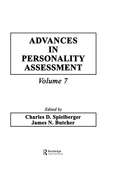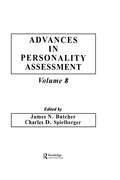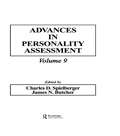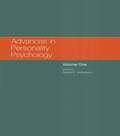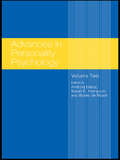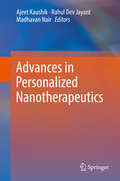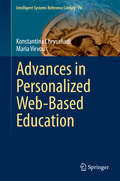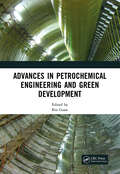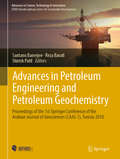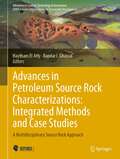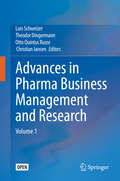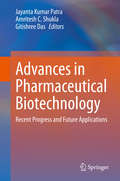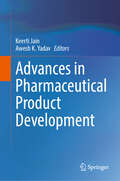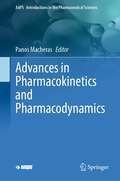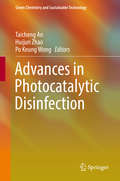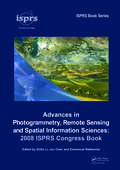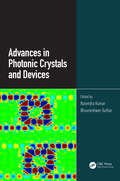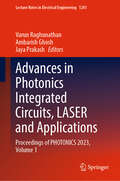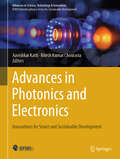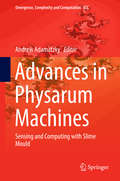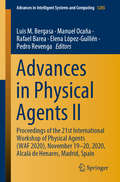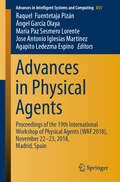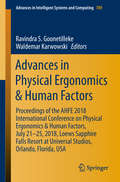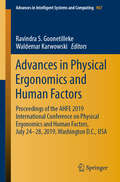- Table View
- List View
Advances in Personality Assessment: Volume 7 (Advances in Personality Assessment Series #Vol. 10)
by James N. Butcher Charles D. SpielbergerThis volume illustrates the diversity in assessment philosophy, theoretical orientation, and research methodology that is characteristic in the field of personality assessment. Topics range from anxiety about test taking and teaching science, to the emotional distress evoked by an environmental catastrophe.
Advances in Personality Assessment: Volume 8 (Advances in Personality Assessment Series #Vol. 10)
by James N. Butcher Charles D. SpielbergerFirst published in 1990. The field of personality assessment continues to grow and expand at a rapid rate. The present volume is a continuation of the author's effort to bring together significant original papers representing diverse theoretical perspectives, critical methodological issues, and a variety of assessment techniques. Diversity of assessment approaches are also considered in the present volume. These vary from traditional assessment approaches, such as the Rorschach and the MMPI, to newer instruments such as Temperament Inventory. This will be of interest to mental health professionals, as it provides new insights and information about important directions in which the field of personality assessment is going.
Advances in Personality Assessment: Volume 9 (Advances in Personality Assessment Series #Vol. 10)
by James N. Butcher Charles D. SpielbergerIn keeping with the goals of this series, which are to facilitate the rapid dissemination of important new developments in theory and research on all aspects of personality assessment, the eight chapters in this volume examine a wide range of topics. These include research investigations and clinical applications involving traditional assessment techniques -- such as the Rorschach and the MMPI-2 -- and promising but less known procedures. Specific topics examined in the individual chapters range from the assessment of appreciation of humor to assessment of marital distress. A review of the contents of this volume once again demonstrates the diversity in assessment philosophy, theoretical orientation, and research methodology that characterizes the field of personality assessment.
Advances in Personality Psychology: Volume 1 (Advances in Personality Psychology)
by Sarah E. HampsonIn the first volume of this new series, Sarah E. Hampson brings together a unique collection of critical reviews of key areas of personality psychology and integrative accounts of important work by internationally recognised experts in the field. Advances in Personality Psychology includes chapters on cross-cultural evidence for the Big-Five framework for personality description, type and trait approaches to understanding childhood personality, developments in psychometrics, the relationship between hostility and cardiovascular disease, and the connections between personality and emotions. In further chapters the view that personality cannot change in adulthood is challenged and the importance of environmental factors is revealed by an observational study of twins. This state-of-the-art volume will provide students, teachers and researchers of contemporary personality psychology with a highly valuable resource on recent developments in this area.
Advances in Personality Psychology: Volume II (Advances in Personality Psychology)
by Andrzej Eliasz Sarah E. Hampson Boele De RaadThe second volume in the Advances in Personality Psychology series, this book presents an authoritative collection of works by leading experts in the field. It focuses on three of the major issues in personality psychology: personality, affect and arousal; personality and intelligence; and personality structure. The first part of the book seeks to analyse cognitive biases dependent on anxiety and the biological foundations of thought and action. It also looks at the influence of temperamental traits on reaction to traumatic events. In the second part, contributions consider the mutual relations between personality and intelligence, the similarities and differences between personality and intelligence, and the cognitive mechanisms of human intelligence and personality. The final part analyses personality structure across cultures and presents a model of personality relevant to situational descriptions. All the authors are experienced and renowned experts in the field of personality psychology. The volume incorporates critical reviews, bringing the reader up-to-date with key issues, and unique data from contemporary empirical research projects, reflecting the diversity and vigour of current work on personality psychology.
Advances in Personalized Nanotherapeutics
by Ajeet Kaushik Rahul Dev Jayant Madhavan NairPersonalized health care to manage diseases and optimized treatment is crucial for everyone to maintain health quality. Significant efforts have been made to design and develop novel nano-enabling therapeutic strategies to cure and monitor diseases for personalized health care. As state-of-the-art, various strategies have been reported to develop personalized nanomedicine to combat against target diseases with no side effects. In this book proposal, we are trying to describe fundamentals of personalized nanomedicine, novel nanomaterials for drug delivery, role of nanotechnology for efficient therapeutics approach, nano-pharmacology, targeted CNS drug delivery, stimuli responsive drug release and nanotechnology for diseases management. This book would serve as a platform for new scholars to understand state-of-the-art of nanotechnology for therapeutics and designing their future research to develop effective personalized nanomedicine against targeted diseases. As of now, various studies have been reported to design and develop nanomedicines of higher efficacy but unfortunately, such products are up to laboratory research only and need to be well-tested using pre-clinical or human models. Our book would be a call for experts to explore multidisciplinary research for developing novel and efficient approaches to explore smart efficient nanocarriers for site-specific on-demand controlled drug delivery to combat against targeted diseases to personalized health care.
Advances in Personalized Web-Based Education (Intelligent Systems Reference Library #78)
by Maria Virvou Konstantina ChrysafiadiThis book aims to provide important information about adaptivity in computer-based and/or web-based educational systems. In order to make the student modeling process clear, a literature review concerning student modeling techniques and approaches during the past decade is presented in a special chapter. A novel student modeling approach including fuzzy logic techniques is presented. Fuzzy logic is used to automatically model the learning or forgetting process of a student. The presented novel student model is responsible for tracking cognitive state transitions of learners with respect to their progress or non-progress. It maximizes the effectiveness of learning and contributes, significantly, to the adaptation of the learning process to the learning pace of each individual learner. Therefore the book provides important information to researchers, educators and software developers of computer-based educational software ranging from e-learning and mobile learning systems to educational games including stand alone educational applications and intelligent tutoring systems.
Advances in Petrochemical Engineering and Green Development: Proceedings of the 3rd International Conference on Petrochemical Engineering and Green Development (ICPEGD 2022), Shanghai, China, 25-27 February 2022
by Bin GuanAdvances in Petrochemical Engineering and Green Development is a compilation of selected papers from the 3rd International Conference on Petrochemical Engineering and Green Development (ICPEGD 2022) and focuses on the research of petrochemical engineering. The proceedings features the most cutting-edge research directions and achievements related to geology and green development. Subjects in this proceedings include: Petroleum and Petrochemical Engineering Fossil Technologies Oil & Gas Production Renewable Energy Sources and Technology Green Synergy Innovation Urban Crisis Management The collection of papers in this proceedings will promote the development of petrochemical industry and energy, resource sharing, flexibility and high efficiency. Thereby, it will promote scientific information interchange between scholars from top universities, research centers and high-tech enterprises working all around the world.
Advances in Petroleum Engineering and Petroleum Geochemistry: Proceedings Of The 1st Springer Conference Of The Arabian Journal Of Geosciences (cajg-1), Tunisia 2018 (Advances in Science, Technology & Innovation)
by Santanu Banerjee Reza Barati Shirish PatilThis edited volume is based on the best papers accepted for presentation during the 1st Springer Conference of the Arabian Journal of Geosciences (CAJG-1), Tunisia 2018. The book is of interest to all researchers in the fields of petroleum engineering, reservoir engineering and petroleum geochemistry. The MENA region accounts for more than 50 percent of the world's hydrocarbon reserves. Despite being the largest oil and gas producer of the world, the MENA countries face routine problems regarding petroleum engineering, reservoir modelling and production optimization. This volume offers an overview of the latest information and ideas regarding reservoir engineering, petrophysical engineering, petroleum system modelling, non-conventional energy resources and environmental impact of oil production.
Advances in Petroleum Source Rock Characterizations: A Multidisciplinary Source Rock Approach (Advances in Science, Technology & Innovation)
by Haytham El Atfy Bandar I. GhassalThis book is directed to those who are interested in petroleum geology, especially source rock from both academia and industrial societies. Our chapter-based book is written by a list of world-class subject-matter experts.The book includes recent advancements in analytical source rock characterization methods with some case studies. It is also used as part of a course curriculum or guide for source rock interpretation for all researcher categories.Significant improvement in the source rock characterization techniques in the last two decades and the knowledge is disseminated in a huge amount of papers and studies. The book intends to collect these recent advancements in one textbook to benefit students and researchers in general. In addition, it is supplemented by many case studies from all over the world that represent important data sets for the regional geology of these areas.
Advances in Pharma Business Management and Research: Volume 1
by Lars Schweizer Theodor Dingermann Otto Quintus Russe Christian JansenThis open access book presents a unique collection of practical examples from the field of pharma business management and research. It covers a wide range of topics such as: 'Brexit and its Impact on pharmaceutical Law - Implications for Global Pharma Companies', 'Implementation of Measures and Sustainable Actions to Improve Employee's Engagement', 'Global Medical Clinical and Regulatory Affairs (GMCRA)', and 'A Quality Management System for R&D Project and Portfolio Management in a Pharmaceutical Company'. The chapters are summaries of master’s theses by "high potential" Pharma MBA students from the Goethe Business School, Frankfurt/Main, Germany, with 8-10 years of work experience and are based on scientific know-how and real-world experience. The authors applied their interdisciplinary knowledge gained in 22 months of studies in the MBA program to selected practical themes drawn from their daily business.
Advances in Pharmaceutical Biotechnology: Recent Progress and Future Applications
by Jayanta Kumar Patra Gitishree Das Amritesh C. ShuklaThis book explains both the basic science and the applications of biotechnology-derived pharmaceuticals, with special emphasis on their clinical uses. The foundations of pharmaceutical biotechnology lie mainly in the capability of plants, microorganism, and animals to produce low and high molecular weight compounds useful as therapeutics. Pharmaceutical biotechnology has flourished since the advent of recombinant DNA technology and metabolic engineering, supported by the well-developed bioprocess technology. A large number of monoclonal antibodies and therapeutic proteins have been approved, delivering meaningful contributions to patients’ lives, and the techniques of biotechnology are also a driving force in modern drug discovery. Due to this rapid growth in the importance of biopharmaceuticals and the techniques of biotechnologies to modern medicine and the life sciences, the field of pharmaceutical biotechnology has become an increasingly important component in the education of pharmacists and pharmaceutical scientists. This book will serve as a complete one-stop source on the subject for undergraduate and graduate pharmacists, pharmaceutical science students, and pharmaceutical scientists in industry and academia.
Advances in Pharmaceutical Product Development
by Keerti Jain Awesh K. YadavThis book discusses the stages involved in pharmaceutical product development including the importance, requirement, and effect of each stage and process. It also covers prototype development for pharmaceutical formulations, scale-up studies, optimization, testing, packaging, and commercialization of different dosage forms for pharmaceutical products like tablets, suspensions, emulsions, coating, inhalational products, sterile products, and herbal formulations. The book also presents advancements in tablet production and tablet coating, including materials, material handling, granulation and granulation technologies, process automation, processing problems in tablet production and troubleshooting, advances in equipment for coating and coating materials. Further, the chapter explores the advances in the formulation and development of aerosols, nebulizers, inhalers, metered Dose Inhalers (MDI), and dry powder Inhalers (DPIs). Towards the end, the book examines the challenges, formulation development, testing, stability, and regulatory guidelines in the development of herbal formulations. This book provides a valuable source of information for the researcher, scientists, students, and people working in the area mainly focused on the challenges in pharmaceutical product development.
Advances in Pharmacokinetics and Pharmacodynamics (AAPS Introductions in the Pharmaceutical Sciences #9)
by Panos MacherasThis book provides a concise overview of recent advances in Pharmacokinetics (PK) and Pharmacodynamics (PD). The pharmacokinetics section covers the state of the art in Physiologically Based Pharmacokinetic (PBPK) modeling (Chapter 1) as well as the assessment of food effect on drug absorption using PBPK modeling (Chapter 2). Chapters 3 and 4 describe the recent development of Physiologically Based Finite Time Pharmacokinetic (PBFTPK) models and their applications to pharmacokinetic data. The pharmacodynamics section focuses on PK/PD modeling. Chapter 5 provides an overview of PK/PD modeling and simulation in clinical practice and studies. Chapter 6 deals with the subject/physiology variability issue encountered in PK/PD studies, while Chapter 7 reviews the influence of clinical pharmacology in the modernization of drug development and regulation. This book is an essential reference for pharmaceutical scientists.
Advances in Photocatalytic Disinfection (Green Chemistry and Sustainable Technology)
by Taicheng An Huijun Zhao Po Keung WongThis book presents the latest results related to photocatalytic inactivation/killing of microorganisms, which is a promising alternative disinfection method that produces less or even no disinfection byproduct. The book is divided into 13 chapters, which introduce readers to the latest developments in the photocatalytic disinfection of microorganisms, examine essential photocatalytic (PC) and photoelectrocatalytic (PEC) disinfection studies, and forecast and make recommendations for the further development of PC and PEC disinfection. Bringing together contributions by various leading research groups worldwide, it offers a valuable resource for researchers and the industry alike, as well as the general public. Taicheng An, PhD, is Chair Professor and Director at the Institute of Environmental Health and Pollution Control, School of Environmental Science and Engineering, Guangdong University of Technology, Guangzhou, China. Huijun Zhao, PhD, is Chair Professor and Director at the Centre for Clean Environment and Energy & Griffith School of Environment, Griffith University, Australia. Po Keung Wong, PhD, is a Professor at the School of Life Sciences, the Chinese University of Hong Kong, Hong Kong SAR, China.
Advances in Photogrammetry, Remote Sensing and Spatial Information Sciences: 2008 ISPRS Congress Book (ISPRS Book Series)
by Jun Chen Zhilin Li Emmanuel BaltsaviasPublished on the occasion of the XXIst Congress of the International Society for Photogrammetry and Remote Sensing (ISPRS) in Beiijng, China in 2008, Advances in Photogrammetry, Remote Sensing and Spatial Information Sciences: 2008 ISPRS Congress Book is a compilation of 34 contributions from 62 researchers active within the ISPRS. The book covers
Advances in Photometric 3D-Reconstruction (Advances in Computer Vision and Pattern Recognition)
by Maurizio Falcone Jean-Denis Durou Yvain Quéau Silvia TozzaThis book presents the latest advances in photometric 3D reconstruction. It provides the reader with an overview of the state of the art in the field, and of the latest research into both the theoretical foundations of photometric 3D reconstruction and its practical application in several fields (including security, medicine, cultural heritage and archiving, and engineering). These techniques play a crucial role within such emerging technologies as 3D printing, since they permit the direct conversion of an image into a solid object. The book covers both theoretical analysis and real-world applications, highlighting the importance of deepening interdisciplinary skills, and as such will be of interest to both academic researchers and practitioners from the computer vision and mathematical 3D modeling communities, as well as engineers involved in 3D printing. No prior background is required beyond a general knowledge of classical computer vision models, numerical methods for optimization, and partial differential equations.
Advances in Photonic Crystals and Devices
by Narendra Kumar Bhuvneshwer SutharIn recent decades, there has been a phenomenal growth in the field of photonic crystal research and has emerged as an interdisciplinary area. Photonic crystals are usually nanostructured electromagnetic media consisting of periodic variation of dielectric constant, which prohibit certain electromagnetic wave frequency ranges called photonic bandgaps to propagate through them. Photonic crystals elicited numerous interesting features by unprecedented control of light and their exploitation is a promising tool in nanophotonics and designing optical components. The book ‘Advances in Photonic Crystals and Devices’ is designed with 15 chapters with introductory as well as research and application based contents. It covers the following highlighted features: Basics of photonic crystals and photonic crystal fibers Different theoretical as well as experimental approaches Current research advances from around the globe Nonlinear optics and super-continuum generation in photonic crystal fibers Magnetized cold plasma photonic crystals Liquid crystal defect embedded with graphene layers Biophysics and biomedical applications as optical sensors Two-dimensional photonic crystal demultiplexer Optical logic gates using photonic crystals A large number of references The goal of this book is to draw the background in understanding, fabrication and characterization of photonic crystals using a variety of materials and their applications in design of several optical devices. Though the book is useful as a reference for the researchers working in the area of photonics, optical computing and fabrication of nanophotonic devices, it is intended for the beginners like students pursuing their masters’ degree in photonics.
Advances in Photonics Integrated Circuits, LASER and Applications: Proceedings of PHOTONICS 2023, Volume 1 (Lecture Notes in Electrical Engineering #1241)
by Jaya Prakash Varun Raghunathan Ambarish GhoshThis book presents the select proceedings of the Biennial Photonics Conference (Photonics 2023) held at IISc, Bengaluru on 5-8 July 2023. It covers topics across multiple areas of photonics, including established areas like optical communication and networks, quantum optics, non-linear and ultrafast photonics, nanophotonics, biophotonics and bioimaging, photonic integrated circuits, fibers and sensors, optical materials and fabrication techniques, optical metrology, and instrumentation, optofluidics, laser applications, optoelectronics. The book also covers emerging areas in photonics, such as THz photonics, structured Light, 2D materials, optomechanics, topological photonics, and AI/ML in photonics. The book will be useful for researchers and professionals interested in the broad field of photonics.
Advances in Photonics and Electronics: Innovations for Smart and Sustainable Development (Advances in Science, Technology & Innovation)
by Aavishkar Katti Ritesh Kumar ChourasiaThe book presents the collated and high-quality proceedings of the Conference on Recent Technologies in Electronics and Photonics held during 9-10 February 2024 at MIT-WPU, Pune, India. The main objective of this book is the introduction of recent innovations and current trends of photonics and electronics along with advanced device applications. Photonics and electronics together are shaping up to be the two main pillars of innovation for sustainable development and technological advances. The emphasis in this book will be on presenting recent application-based research in the mentioned fields rather than purely theoretical ideas. The readers will gain insights on recent innovations across many fields of photonics on one hand: laser science and nonlinear optics, photonic materials, nanophotonics, solar photovoltaics, optoelectronics, green photonics, and fiber optics and a diverse set of topics in electronics on the other: Semiconductor Electronics, Electronic Materials, Microelectronics, AI/ML, Internet of Things etc. The book is useful for early career researchers in Science and Engineering, as also university professors and industry professionals.
Advances in Physarum Machines: Sensing and Computing with Slime Mould (Emergence, Complexity and Computation #21)
by Andrew AdamatzkyThis book is devoted to Slime mould Physarumpolycephalum, which is a large single cell capable for distributed sensing,concurrent information processing, parallel computation and decentralizedactuation. The ease of culturing and experimenting with Physarum makes thisslime mould an ideal substrate for real-world implementations of unconventionalsensing and computing devices The book is a treatise of theoretical and experimentallaboratory studies on sensing and computing properties of slime mould, and onthe development of mathematical and logical theories of Physarum behavior. It is shown how to make logical gates and circuits,electronic devices (memristors, diodes, transistors, wires, chemical andtactile sensors) with the slime mould. The book demonstrates how to modifyproperties of Physarum computing circuits with functional nano-particles andpolymers, to interface the slime mould with field-programmable arrays, and touse Physarum as a controller of microbial fuel cells. A unique multi-agent model of slime is shown to servewell as a software slime mould capable for solving problems of computationalgeometry and graph optimization. The multiagent model is complemented bycellular automata models with parallel accelerations. Presented mathematical modelsinspired by Physarum include non-quantum implementation of Shor'sfactorization, structural learning, computation of shortest path tree ondynamic graphs, supply chain network design, p-adic computing and syllogisticreasoning. The book is a unique composition of vibrant andlavishly illustrated essays which will inspire scientists, engineers andartists to exploit natural phenomena in designs of future and emergentcomputing and sensing devices. It is a 'bible' of experimental computing withspatially extended living substrates, it spanstopics from biology of slime mould, to bio-sensing, tounconventional computing devices and robotics, non-classical logics and music and arts.
Advances in Physical Agents II: Proceedings of the 21st International Workshop of Physical Agents (WAF 2020), November 19-20, 2020, Alcalá de Henares, Madrid, Spain (Advances in Intelligent Systems and Computing #1285)
by Luis M. Bergasa Manuel Ocaña Rafael Barea Elena López-Guillén Pedro RevengaThe book reports on cutting-edge Artificial Intelligence (AI) theories and methods aimed at the control and coordination of agents acting and moving in a dynamic environment. It covers a wide range of topics relating to: autonomous navigation, localization and mapping; mobile and social robots; multiagent systems; human-robot interaction; perception systems; and deep-learning techniques applied to the robotics. Based on the 21st edition of the International Workshop of Physical Agents (WAF 2020), held virtually on November 19-20, 2020, from Alcalá de Henares, Madrid, Spain, this book offers a snapshot of the state-of-the-art in the field of physical agents, with a special emphasis on novel AI techniques in perception, navigation and human robot interaction for autonomous systems.
Advances in Physical Agents: Proceedings of the 19th International Workshop of Physical Agents (WAF 2018), November 22-23, 2018, Madrid, Spain (Advances in Intelligent Systems and Computing #855)
by Raquel Fuentetaja Pizán Ángel García Olaya Maria Paz Sesmero Lorente Jose Antonio Iglesias Martínez Agapito Ledezma EspinoThe book reports on cutting-edge theories and methods aimed at the control and coordination of agents acting and moving in a dynamic environment. It covers a wide range of systems, including multiagent systems, domotic agents, robotic manipulators, soccer robots, autonomous and semiautonomous robots, as well as systems for industrial applications. Advances in software agents, sensors, computer visions and other related areas are also thoroughly discussed and presented in detail. Based on the 19th edition of the International Workshop of Physical Agents (WAF 2018), held on November 22-23, 2018, in Madrid, Spain, this book offers a snapshot of the state-of-the-art in the field of physical agents, with a special emphasis on autonomous systems such as mobile robots, industrial process or other complex systems.
Advances in Physical Ergonomics & Human Factors: Proceedings of the AHFE 2018 International Conference on Physical Ergonomics & Human Factors, July 21-25, 2018, Loews Sapphire Falls Resort at Universal Studios, Orlando, Florida, USA (Advances in Intelligent Systems and Computing #789)
by Waldemar Karwowski Ravindra S. GoonetillekeThis book reports on the state of the art in physical ergonomics and addresses the design of products, processes, services, and work systems to ensure they are productive, safe, and enjoyable for people to use. The human body’s responses to physical and physiological work demands, strain injuries from repetition, vibration, force, and posture are the most common types of issues examined, along with their design implications. The book explores a wide range of topics in physical ergonomics, including the consequences of repetitive motion, materials handling, workplace safety, the usability of portable devices, design, working postures, and the work environment. Mastering physical ergonomics and safety engineering concepts is fundamental to creating products and systems that people can safely and conveniently use, as well as avoiding stresses and minimizing the risk of accidents. Based on the AHFE 2018 Conference on Physical Ergonomics and Human Factors, held on July 21–25, 2018, in Orlando, Florida, USA, this book provides readers with a comprehensive perspective on the current challenges in physical ergonomics, which is a critical aspect in the design of any human-centered technological system, and for factors influencing human performance.
Advances in Physical Ergonomics and Human Factors: Proceedings Of The Ahfe 2017 Conference On Physical Ergonomics And Human Factors, July 17-21, 2017, Los Angeles, California, Usa (Advances in Intelligent Systems and Computing #602)
by Waldemar Karwowski Ravindra S. GoonetillekeThis book reports on the state of the art in physical ergonomics and is concerned with the design of products, process, services, and work systems to assure their productive, safe, and satisfying use by people. With focus on the human body's responses to physical and physiological work demands, repetitive strain injuries from repetition, vibration, force, and posture are the most common types of issues examined, along with their design implications. The book explores a wide range of topics in physical ergonomics, which includes the consequences of repetitive motion, materials handling, workplace safety, and usability in the use of portable devices, design, working postures, and the work environment. Mastering physical ergonomics and safety engineering concepts is fundamental to the creation of products and systems that people are able to use, as well as the avoidance of stresses and minimization of the risk of accidents. Based on the AHFE 2016 International Conference on Physical Ergonomics & Human Factors, held on July 27-31, 2016 in Walt Disney World®, Florida, USA, the book provides readers with a comprehensive view of the current challenges in Physical Ergonomics, which are a critical aspect in the design of any human-centered technological system, and factors influencing human performance.
